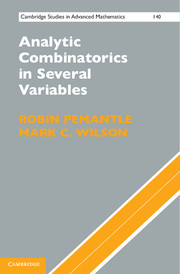Book contents
- Frontmatter
- Contents
- Preface
- PART I COMBINATORIAL ENUMERATION
- PART II MATHEMATICAL BACKGROUND
- 4 Fourier-Laplace Integrals in One Variable
- 5 Fourier-Laplace Integrals in More than One Variable
- 6 Techniques of Symbolic Computation via Gröbner Bases
- 7 Cones, Laurent Series, and Amoebas
- PART III MULTIVARIATE ENUMERATION
- PART IV APPENDIXES
- References
- Author Index
- Subject Index
6 - Techniques of Symbolic Computation via Gröbner Bases
Published online by Cambridge University Press: 05 July 2013
- Frontmatter
- Contents
- Preface
- PART I COMBINATORIAL ENUMERATION
- PART II MATHEMATICAL BACKGROUND
- 4 Fourier-Laplace Integrals in One Variable
- 5 Fourier-Laplace Integrals in More than One Variable
- 6 Techniques of Symbolic Computation via Gröbner Bases
- 7 Cones, Laurent Series, and Amoebas
- PART III MULTIVARIATE ENUMERATION
- PART IV APPENDIXES
- References
- Author Index
- Subject Index
Summary
Solving Systems of Polynomial Equations
The critical point equations, (8.3.1) and (8.3.2), are algebraic equations whose solution is one step in the process of producing asymptotics for ar. Even when F is rational, these algebraic points are specified only as common solutions to sets of polynomial equations, so what does it mean to “find” them? One could at this point include a discussion of numerical methods. Neither of us is an expert in these, and besides, there is a different point to be made here. The point z(r) determines the exponential growth rate, but computations of the exact leading term require further computations for which z(r) is an input. It is good practice to maintain analytic forms for the inputs through as much of the computation as possible to take advantage of algebraic simplifications. Even if one is content to remain at the level of exponential growth rates, it would be desirable to maintain analytic expressions such as z(r) to do calculus on them.
As algebraic geometers have long known, the best way to keep track of algebraic numbers is via the ideals of polynomials that annihilate them. In the last twenty years, the field of computational algebra has burgeoned, providing algorithms for manipulating these ideals and settling questions such as ideal membership and equality of ideals. During the latter part of this period, these results have been implemented, so that packages for manipulating polynomial ideals are now available in many different computing platforms.
Information
- Type
- Chapter
- Information
- Analytic Combinatorics in Several Variables , pp. 106 - 119Publisher: Cambridge University PressPrint publication year: 2013
